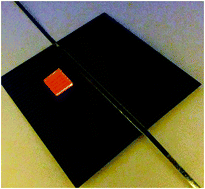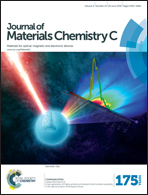Ligand exchange as a tool to improve quantum dot miscibility in polymer composite layers used as luminescent down-shifting layers for photovoltaic applications†
Abstract
The efficiency of solar cells with a poor UV response can be improved by altering the incident light spectrum with luminescence down-shifting (LDS). Stable luminescent additives with a large Stokes shift, high photoluminescence quantum yield (PLQY) and a high absorption coefficient are required for this purpose. Quantum dots (QDs) are attractive candidates which meet most of the basic requirements for LDS additives. Herein, commercially available heavy metal free core shell CuInS2/ZnS QDs are theoretically and experimentally evaluated as LDS additives. The small apolar dodecanethiol (DDT) ligands of the QDs are exchanged with thiol functional oligo-caprolactone ligands, via a ligand exchange process, to improve the QD compatibility with the UV curable resin matrix. Aggregation of the QDs is prevented to a large extent in the polymer–QD composite films and the material exhibits luminescence properties which are virtually identical to the luminescence of the QDs dispersed in chloroform. Raman spectroscopy and NMR spectroscopy are used to elucidate the ligand exchange and ligand binding processes. It is shown that well-dispersed CuInS2/ZnS QDs are required with a near unity quantum yield to increase the efficiency of solar cells significantly especially if high performance inorganic solar cells are employed.


 Please wait while we load your content...
Please wait while we load your content...